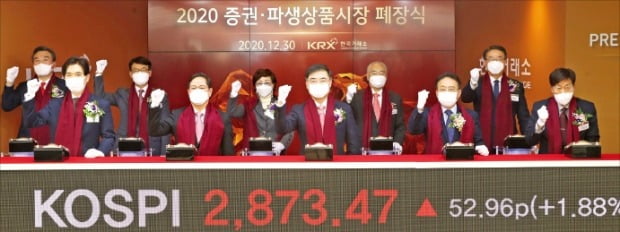
At the ‘2020 Securities and Derivatives Market Closing Ceremony’ held at the Korea Exchange’s Busan headquarters from 3 p.m. on the 30th, attendees such as Son Byeong-du, the new chairman of the Korea Exchange (middle of the front row), are shouting a fight behind the KOSPI index board that closed at an all-time high. Provided by Korea Exchange
Various records were poured out in the Korean stock market this year. It is not just because the KOSPI has exceeded the long-term box range. Various new records emerged one after another in the process of creating the Donghak Ant Movement by gathering the power of’ants’ (individual investors) scattered like sand grains.
There were also changes in the topography of the capital. The growth of high-tech industries accelerated as the non-face-to-face culture spread due to Corona 19. Bio, rechargeable battery, and internet stocks rose to the top of the market cap. Steel and oil refining industries were pushed out of the rankings.
The rise of individuals and the growth of the high-tech industry provided an opportunity for the Korean stock market to be re-evaluated. That is why experts look at the stock market in 2021 positively.
Individual net purchase 64 trillion won
The main players that raised the KOSPI index to 2873 this year were ants. Individual investors net bought 47,491.5 billion won in the securities market this year. Whenever foreigners and institutions pressed the stock price, they defended the stock price with a united force. This year, foreigners sold 24,5654 trillion won, and institutions 25,534.6 billion won.
Until last year, ants had no presence. The perception that the securities market is led by the’big hand’ was prevalent. Individuals sold 11,801.2 billion won worth in the securities market last year. Even in 2018, when the KOSPI index rose to 2600, the net purchase amount was only 7.45 trillion won. It can be interpreted that this year’s ants showed unprecedented firepower. In addition, stock deposits that can come into stock at any time are increasing.
The ants also showed their presence in the’home ground’. This year, individuals net bought 16,335.5 billion won in the KOSDAQ market. Although the institution sold more than 10 trillion won, the individual’s buying trend raised the index. On the 30th, the KOSDAQ index ended at 968.42, up 1.15%. It is just 30 points ahead of the 1000 era.
The main indicator is the highest
As individuals rise, all major indicators of the stock market are at their highest. Securities companies’ customer deposits recently exceeded 64 trillion won. It has more than doubled from 28.519.4 billion won at the end of last year. The number of stock accounts is recording 3548,3992, an increase of 6.13 million from the beginning of the year. From their teens to their 70s to 80s, they started investing in stocks. Currently, the number of accounts is far more than the 28.2 million economically active population.
There is also a point of concern. The’debt investment’ is the highest ever. According to the Financial Investment Association, the credit balance of individuals rose to 19.34 trillion won (30 days). This is twice the level of the end of last year (9,2181 billion won). This year, many individuals bought it, but risky investments also increased.

LG Chem ranked 3rd in the market cap
Another term summarizing the stock market this year is’BBIG7′. BBIG7 refers to 7 major stocks in the bio, battery, internet, and game industries. Stock prices for these stocks soared as a result of the spread of non-face-to-face culture. The total market capitalization of BBIG7 stocks such as LG Chem, Naver, and Celltrion surged from 146.3684 billion won at the end of last year to 307 trillion 400 billion won at the end of this year. The share of the market capitalization of the securities market also exceeded 15%.
As BBIG7 advances, the top market cap stocks have also changed. At the end of last year, Hyundai Mobis (6th) and POSCO (10th), which were in the top 10, disappeared, and Samsung SDI and Kakao filled the spot. LG Chem, which also raised expectations for the Green New Deal, rose to the third place in the market cap.
KOSDAQ beat Nasdaq
The change produced by the growth of the high-tech industry and the advancement of individuals is the rate of return. The KOSPI index, which has been locked in the box area for the past 10 years, is at the highest level this year. It has risen 32.1% since the beginning of the year. Compared to March 23, the lowest point since Corona 19, the increase rate reaches 93.9%. The KOSDAQ index, which ranked first in the index increase rate in major countries, has risen 43.6% since the beginning of the year. Compared to the lowest point in March, it rose a whopping 126%.
The S&P 500, the representative US stock index, has risen 14.4% since the beginning of the year. During the same period, the Shanghai Composite Index rose 10.6%. The Nikkei 255 index also rose only 18.3%. All of them fall short of the KOSPI increase rate. The Nasdaq Index, which was notable for its steep growth rate, also rose 41.3% this year and failed to keep up with the KOSDAQ.
The Korean stock market is expected to continue strong next year. Securities companies are adjusting their target for the year-end KOSPI to more than 3000.
Reporter Park Uimyung [email protected]
